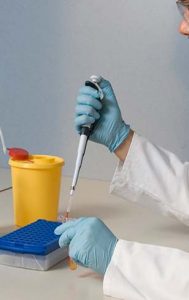Ron Hines DVM PhD
 See What Normal Blood & Urine Values Are
See What Normal Blood & Urine Values Are
 Causes Of Most Abnormal Blood & Urine Tests
Causes Of Most Abnormal Blood & Urine Tests
Your Pet’s Serum Lipase Level = LIP
Lipases are a group of enzymes your dog and cat produce to help it absorb and utilize the fats in its diet. The one that veterinarians are most interested in is the one produced by your pet’s pancreas to aid in digestion. Your pet’s pancreatic ducts (common bile duct in cats) normally carries that lipase from the pancreas to its intestine.
Anything that disrupts the flow of lipase, or ruptures the pancreatic acinar cells whose job it is to manufacture it, has the ability to raise the level of lipase in your pet’s blood. So, when your dog or cat is ill with signs of abdominal (tummy) discomfort and your veterinarian runs standard blood chemistry profiles, and sees an elevated serum lipase level, the first thing that is likely to come to your veterinarian’s mind will be that your pet’s pancreatic could be involved.
Unfortunately, serum lipase levels are not all that accurate in determining if a pancreatic problem does or does not exist. That is because many organs produce lipases. (read here) The generic lipase blood test measures too many different body lipase sources any of which could be the source. Lipase levels also fluctuate rapidly (a short half-life), and pancreatic problems can exist in dogs and cats even when total blood lipase levels are normal. So, an elevated level really means that other more specific tests need to be run and a normal total blood lipase read should not cross pancreatic problems entirely off your vet’s diagnostic list. However, when your pet’s total blood lipase levels are at least 3x normal, the test is considerably more reliable in accurately pointing to your dog or cat’s pancreas as the likely source. Much less so when the elevation is less than that.
Less than dramatic (1.5 – 3 times normal) increases in lipase are very hard to interpret. Also, almost a third of dogs with confirmed pancreatitis have normal lipase levels. The test is even less accurate in diagnosing pancreatitis in cats. So, your vet will have to run or send off other tests before deciding what a change in your pet’s blood lipase level might really mean. Luckily, newer, more specific tests are available; and some can be run right in the office. They are the cPL, fPL, cTLI, fTLI, TLI tests. (the links are given at the bottom of this page).
Reasons Why Your Dog or Cat’s Serum Lipase Levels Might Be High:
Acute Pancreatitis (sudden=acute), the administration of corticosteroid medications (e.g. prednisone), liver disease, kidney failure (in dogs or in cats), abdominal infections (peritonitis), digestive tract obstructions, recent abdominal surgery, pancreatic tumors and bile duct obstruction can all raise your dog and cat’s serum lipase levels.
Lipemic (fatty) blood samples (fatty sample), can falsely lower the pet’s lipase reading, resulting in a false normal or subnormal blood lipase level. Hemolyzed blood samples can falsely raise your pet’s blood lipase readings.
Complementary Tests:
Blood amylase level, pancreatic lipase immunoreactivity tests (= PLI, cPL, fPL), GDH, repeat (serial) lipase tests to validate and judge the success of treatment, TLI (less valuable in cats), CBC/ WBC to evaluate general health and blood chemistry panel, urinalysis, abdominal ultrasound exam
DxMe



